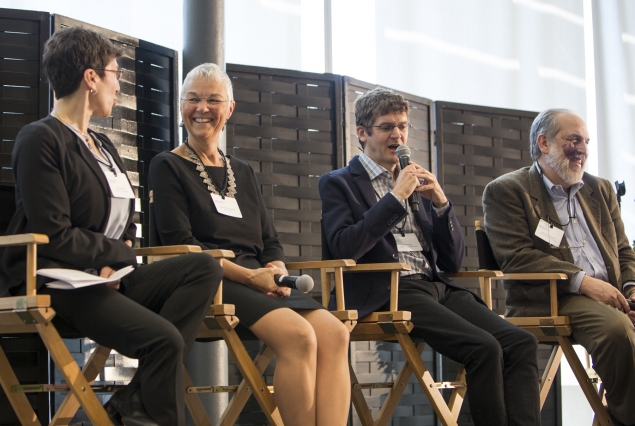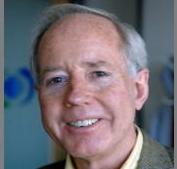Second-annual conference looks at MIT’s progress toward sustainability goals, and what remains to be done.
***
SustainabilityConnect 2016, the second annual conference sponsored by MIT’s Office of Sustainability, embraced the local and the global in equal measure. Held on May 9 in the newly renovated Building E52, the conference drew faculty, students, and staff from across the Institute and addressed issues ranging from rising sea levels to greenhouse gas emissions, from green labs to an MIT roof study.
An overarching message for the day was that achieving sustainability requires both commitment and innovation. Locally, the speakers said, MIT is creating a next-generation sustainability platform, an open data hub to help make informed decisions, and a living laboratory to experiment with solutions.
 On a larger scale, they observed, MIT needs to model forward-thinking strategies and share lessons learned as widely as possible. Collaboration is key: with colleagues, researchers, entrepreneurs, inventors, industry, community partners, and experts at other universities.
On a larger scale, they observed, MIT needs to model forward-thinking strategies and share lessons learned as widely as possible. Collaboration is key: with colleagues, researchers, entrepreneurs, inventors, industry, community partners, and experts at other universities.
As Julie Newman, director of the MIT Office of Sustainability, noted in her opening remarks, MIT has already taken some important steps in the year since the first SustainabilityConnect conference was held.
First, the Office of Sustainability formalized its framework to consider the role of the individual, the campus, the city, and the globe. It has committed to transforming MIT into a powerful model that generates new and proven ways of responding to the challenges of a changing climate through operational excellence, education, research, and innovation on campus.
Second, in October 2015, MIT published its Plan for Action on Climate Change, which included MIT’s first public greenhouse gas goal, to reduce its emissions by at least 32 percent below 2014 levels by 2030. This goal was later amended to serve as a starting point while MIT seeks carbon neutrality as soon as possible. And third, in November 2015, the MIT Campus Sustainability Working Groups released their collective recommendations, setting foundational strategies for sustainable design and construction, materials management, storm water and land management, and green labs.
Tony Sharon, the deputy executive vice president, outlined five key elements of MIT’s sustainability goals: reducing emissions, limiting the use of fuel oil, enacting carbon pricing, deploying an open data platform, and activating the campus as a living lab.
Sharon also recalled key points made by MIT President L. Rafael Reif when the Plan for Action on Climate Change was released, including the fact that climate change is a complex and global problem, an MIT-class problem. The Institute has to apply innovative ideas across the spectrum, from the design of major capital projects to lab renovations, building and system renewal, operations and maintenance. To make progress, Sharon said, we’re going to need to move on all fronts.
The conference included presentations and moderated panels on three topic areas: Campus Resiliency through Community Design; 32 Percent and Beyond: MIT’s Role in Meeting Local & Global Climate Goals; and Campus as a Living Lab: Reflections from Three Project Teams.
During the opening panel, Brent Ryan, an associate professor in the Department of Urban Studies and Planning, discussed the impact of rising tides. By 2100, the sea level in Massachusetts is expected to rise by 1.5 to 6 feet. An estimated 300,000 individuals may need to be relocated. This will have major impacts on transportation and require resettlement strategies. Ryan discussed making use of open spaces and low-density parcels to address housing needs.
Maryanne Kirkbride, clinical director for campus life in MIT Medical, spoke about the benefits of an intentionally built community on campus, ranging from trusted networks to positive environmental changes, such as walls made of plants, community gardens, and more welcoming places for people to sit outside.
Larry Susskind, a professor in the Department of Urban Studies and Planning, discussed a climate vulnerability assessment for the City of Cambridge based on temperature, sea level, and precipitation. He noted that impacts from climate change are already taking place, from flooding to loss of power due to heat waves and storm intensity. Environmental risks also lead to public health risks. Susskind advocates thinking through possible near- and long-term actions, and developing adaptation strategies.
 The first presenter on the topic of 32 Percent and Beyond, Ron Prinn, is director of the Center for Global Change Science. He discussed the “greenhouse gamble,” the challenges resulting from a 2-degree Celsius increase in temperature. These range from the depletion of Arctic ice, to shifting climate zones and destructive hurricanes, to increases in ocean acidity. Mitigation is essential, from working on carbon capture to switching to renewable energy sources to wasting less of the energy we use.
The first presenter on the topic of 32 Percent and Beyond, Ron Prinn, is director of the Center for Global Change Science. He discussed the “greenhouse gamble,” the challenges resulting from a 2-degree Celsius increase in temperature. These range from the depletion of Arctic ice, to shifting climate zones and destructive hurricanes, to increases in ocean acidity. Mitigation is essential, from working on carbon capture to switching to renewable energy sources to wasting less of the energy we use.
Steven Lanou, deputy director of the Office of Sustainability, discussed the challenges here on campus. Most of MIT’s greenhouse gas emissions come from the energy used in MIT buildings, as well as the fuels used in the Central Utilities Plant and in MIT vehicles. Of the MIT baseline established in 2014 — 204,000 metric tons of CO2 emissions — 96 percent came from energy supplied to MIT buildings for heating, cooling, and electricity. In 2015, MIT made progress toward reducing its emissions. Energy efficiency played a major role, through structured programs with MIT’s utilities and wholesale retrofits across campus. But, Lanou acknowledged, many more initiatives will be needed to meet the 32 percent goal and beyond.
Joe Higgins, director of infrastructure business operations, focused on three dimensions for reducing emissions: improving the efficiency of our energy production and supply; reducing the energy we all use; and growing sources of renewable energy. He pointed out that renewable strategies from MIT researchers are reaching both local and global communities. He also noted that MIT’s 2014 emissions baseline is likely to grow due to developments in Kendall Square and the MIT.nano building. The good news: This growth in emissions will be offset by central energy plant enhancements (microgrids) going online in 2020 — a bridge to the future energy economy.
Transforming the MIT campus into a living lab is already under way, said John Attunuci, manager of the MIT Transit Lab, and Corey Tucker, a graduate student in MIT’s Technology and Policy Program. Tucker described AccessMyCommute, a tool that lets staff review their commuting patterns to and from MIT and participate in a rewards program for choosing the MBTA, a carpool, or other environmentally conscious modes of transport. AccessMyCommute can be found online through Atlas, under Commuting Benefits.
Taya Dixon, senior planner in the Department of Facilities, and Isaac LaJoie, a student in the Department of Mechanical Engineering, have been exploring sustainable options for MIT rooftops. In a 2.627 (Fundamentals of Photovoltaics) class, LaJoie focused on the benefits of photovoltaic (PV) solar panels. He used Mapdwell software, developed at MIT by Christoph Reinhart, head of the Sustainable Design Lab; it takes satellite imaging, along with roof pitch and shading, to estimate the energy generated from specific solar designs. LaJoie came up with 20 buildings across campus with the highest PV generation and, with his fellow classmates, has presented this information to the Department of Facilities. Dixon detailed how MIT Facilities is actively looking at roof options with respect to energy conservation (solar panels, insulation, white roofs), management of storm-water runoff, and community benefits, such as rooftop gardens and spaces for research.
The last presentation, 2100 Resiliency Planning, was given by Mike Wilson, a graduate student in urban studies and planning, and Jacqueline Kuo, an undergraduate in mechanical engineering. Both were involved in course 11.123 (Big Plans, Adapting MIT to Climate Change). Starting with modeling done by the City of Cambridge, students were asked what they would want Cambridge to look like in 2070, in the face of climate-based changes. Kuo’s team focused on heat issues. In 2070, temperatures here will feel like South Carolina today. Her team proposed a shift from a culture that lives indoors to one that can freely move outdoors, with amenities such as food trucks and places for performance and play. All teams in the Big Plans class stressed the importance of connectedness, open space, and a sense of community.
After lunch, the MIT Science Impact Collaborative sponsored a workshop in which participants prioritized climate-related risks in Cambridge and at MIT and the steps that could be taken to manage health risks caused by climate change. Results will be shared with the City of Cambridge to enhance MIT’s participation in local climate planning.
A fitting wrap-up to the conference came from John Fernandez, director of the Environmental Solutions Initiative, who said: “Today is a great example of the coexistence of incremental efforts along with big radical visions, and frankly, we need to do both. The time is now.”
For more information about the day, visit: sustainability.mit.edu/sustainabilityconnect.